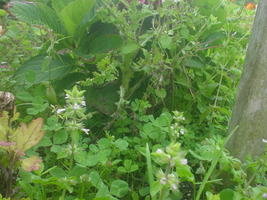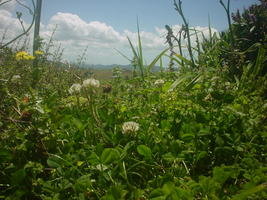





(Editor's Note: This article was originally published on February 25, 2008. Your comments are welcome, but please be aware that authors of previously published articles may not be able to promptly respond to new questions or comments.)
Weeds. Basically, plants growing where you don't want them. This can be subjective though. My friend in New Zealand was complaining about the weeds growing in her garden, nasturtiums, of all things. This is ironic because I just ordered nasturtium seeds to grow IN my garden. Which proves the point, one man's weed could be another man's sought-after treasure. The lady that lives next door considers catnip a weed, I let it grow because, well, I have six cats. Even your good old lawn grass, if it decides to grow outside of the lawn, suddenly becomes an unwelcome weed. Mom and I are always arguing about the milkweeds. I like them; she thinks they are weeds and will yank them on sight. I think I won the battle this past summer though, when I pointed out a few monarch butterfly caterpillars on my highly guarded patch, now she wants some in her third of the garden. Thank you monarchs!!
Controlling weeds can be difficult at best. Every area in the world has native plants that spread by seeds, roots, berries, etc. Yes, most weeds are just native wild plants, or in some cases accidently introduced species, that have the nerve to grow in our carefully tended gardens. Birds, mice, squirrels, chipmunks, the wind, all aid in the spreading of these plants. Of course, the guy across the road who never mows his lawn doesn't help either.
Your best bet for controlling weeds is to pull them before they get a head start on you, like they did in the picture above. Remember the old saying, "One year's seed will give seven years' weeds". If you do not have a lot of time though, this can be difficult. If pulling weeds singly, try to get the entire root system. I always have my little garden trowel in hand, I leave it at the back door and grab it every single time I go outside, it is a permanent extension of my arm in the summer.
The best method for me, when dealing with a large patch of weeds, like you would see in a new garden bed that has been dug but not planted, is to turn them over with a shovel. Bury the little devils. If you are feeling extra energetic, you could pick them up while they are laying helpless, give them a little shake and mulch them. This isn't really necessary since just being buried, and I mean absolutely no green showing on the surface, will mulch them naturally. This is also how I edge my beds, I take the shovel and turn over a few inches all along the edge. Keeps any encroaching lawn at bay.
Having a dog helps. When I got my dog Sandi I found weeding the gardens easier. Every time she needed to be taken outside, which can be many, many times a day, I would walk her along a different section of flower bed. She would sniff around and do her business, I would enjoy the beauty of the flowers and pull any weeds I saw.
There are many different kinds of mulch available. These help, to a point. Eventually, the weeds will grow. Usually when you aren't looking. A friend of mine spent an amazing amount of money and bought herself some pretty red mulch. Spent days putting it in her flower beds, 6 inches deep. I just smiled. I have to admit, it looked great, but by the end of the summer, it looked a lot like the hayfield out back.
Identifying weeds is a whole other problem. I found many weed identification web-sites with a quick "Google". It really depends on your area of the world. The ones I found included feverfew and foxglove in their list of nasty weeds. These two, for me, are highly sought after. I can only suggest that you get to know your native plants. Knowing what annuals and perennials you have in your gardens is helpful here too. When I see something that I know I did not plant, and it looks nothing like any of its neighbours, I start to think weed. Then I start to run through the list of known weeds in my head, clover, alfalfa, nettle, burdock, dandelion, etc. If I cannot identify it as a weed, I will leave it be, let it grow some, and when it flowers I will decide if it's a weed or something I might like to keep. The birds have brought me some nice surprises over the years. Mullein is one of these surprises I decided to keep. cardinal flower (Lobelia cardinalis) is another. You see, weeds aren't always a bad thing. Daisies and brown-eyed susans are other so-called weeds that I allow to grow in my gardens. They grow fast, bloom profusely and make nice tall fillers between other perennials.
foxglove in their list of nasty weeds. These two, for me, are highly sought after. I can only suggest that you get to know your native plants. Knowing what annuals and perennials you have in your gardens is helpful here too. When I see something that I know I did not plant, and it looks nothing like any of its neighbours, I start to think weed. Then I start to run through the list of known weeds in my head, clover, alfalfa, nettle, burdock, dandelion, etc. If I cannot identify it as a weed, I will leave it be, let it grow some, and when it flowers I will decide if it's a weed or something I might like to keep. The birds have brought me some nice surprises over the years. Mullein is one of these surprises I decided to keep. cardinal flower (Lobelia cardinalis) is another. You see, weeds aren't always a bad thing. Daisies and brown-eyed susans are other so-called weeds that I allow to grow in my gardens. They grow fast, bloom profusely and make nice tall fillers between other perennials.
It only takes a few minutes a day to keep ahead of the weeds. The more you weed, the fewer weeds you will have. By the middle of the summer, I really have to look hard to find a weed to pull. The more you pull, the fewer you will have.Take a stroll with your morning coffee. Walk the dog instead of just opening the door for him/her. Don't look at weeding as a nasty chore; you will be less likely to get it done. Look at weeds as the possibility of a new treasure.
Many thanks to my friend Slant in anew Zealand, who gladly shared with me some of her weeds...
Copyright © www.100flowers.win Botanic Garden All Rights Reserved